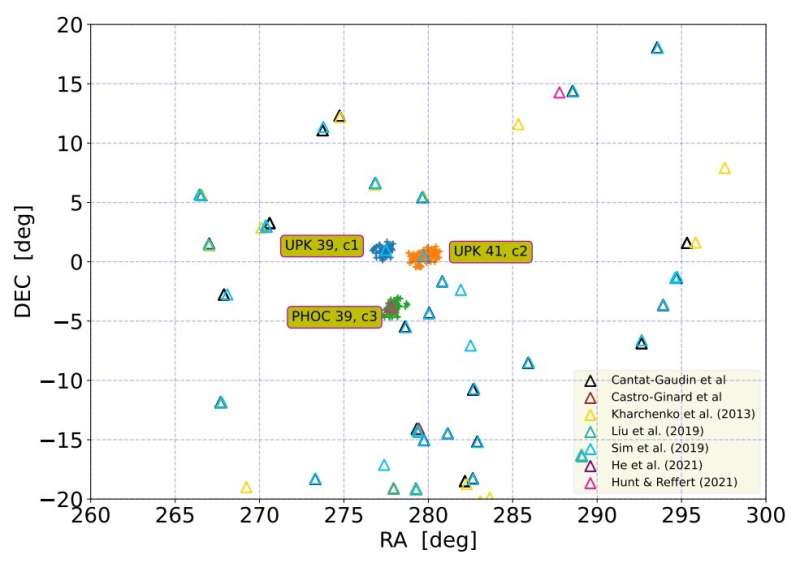
Using data from ESA’s Gaia satellite and the Large Sky Area Multi-Object Fiber Spectroscopic Telescope (LAMOST), astronomers have investigated three open clusters near the Aquila Rift cloud. They found that two of them, designated UPK 39 and UPK 41, constitute a primordial binary open cluster. The discovery is reported in a paper published July 28 on arXiv.org.
Open clusters (OCs), formed from the same giant molecular cloud, are groups of stars loosely gravitationally bound to each other. So far, more than 1,000 of them have been discovered in the Milky Way, and scientists are still looking for more, hoping to find a variety of these stellar groupings. Expanding the list of known galactic open clusters and studying them in detail could be crucial for improving our understanding of the formation and evolution of our galaxy.
Recently, a team of astronomers led by Xianhao Ye of the University of Chinese Academy of Sciences in Beijing, China, has observed open clusters in the region around the Aquila Rift cloud. They further inspected three OCs with similar proper motions and radial velocities, namely UPK 39, UPK 41 and PHOC 39.
“We investigate the three open clusters near Aquila Rift cloud, named as UPK 39 (c1 hereafter), UPK 41 (c2 hereafter) in Sim et al. (2019) and PHOC 39 (c3 hereafter) in Hunt & Reffert (2021), respectively. (…) Their proper motions and radial velocities, estimated using data from Gaia and LAMOST are very similar,” the researchers wrote in the paper.
The study found that UPK 39, UPK 41 and PHOC 39 have similar proper motions and that the difference in radial velocity between UPK 39 and UPK 41 is less than 3 km/s. The ages of UPK 39, UPK 41 and PHOC 39 were estimated to be about 6.3, 8.1 and 21.8 million years, respectively.
LAMOST data indicate that UPK 39 and UPK 41 have median metallicity at a level of approximately -0.26 dex. This value was calculated by taking into account 21 member candidates of each cluster with the smallest metallicity uncertainties.
All in all, based on relative distances, kinematics, ages, and metallicities, the astronomers assume that UPK 39 and UPK 41 are a primordial binary cluster, formed simultaneously. When it comes to PHOC 39, it formed earlier and has a higher metallicity—approximately -0.12 dex.
The researchers added that it is unlikely that PHOC 39 triggered the formation of the other two clusters. However, they do not exclude the possibility that this OC may capture UPK 39 and UPK 41 in the future.
“We conclude that c1 and c2 are a primordial binary open cluster, which are likely to have been formed at the same time, and c3 may capture c1, c2 in the future,” the authors of the paper wrote.
Explore further
Xianhao Ye, Jingkun Zhao, Terry D. Oswalt, Yong Yang, Gang Zhao, Revisit of open clusters UPK 39, UPK 41 and PHOC 39 : a new binary open cluster found. arXiv:2207.14229v1 [astro-ph.GA], arxiv.org/abs/2207.14229
© 2022 Science X Network
UPK 39 and UPK 41 form a primordial binary open cluster, study finds (2022, August 8)
retrieved 8 August 2022
from https://phys.org/news/2022-08-upk-primordial-binary-cluster.html
part may be reproduced without the written permission. The content is provided for information purposes only.